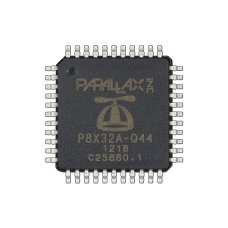


#PROPELLER PARALLAX CODE#
For speed intensive applications you run a supervisor SPIN program with PASM code inline loaded into the cogs and executed. The Propeller Assembler (PASM) is fully documented and powerful. There are C/C++ tools available now for the Propeller. I found SPIN was easy to use, powerful, but slow. The interpreted high-level language is called SPIN. This is generally not true, in-fact the part is designed to let all the cogs run independently in parallel. One popular misconception is that the commutating bus slows down the individual cogs. There are two powerful timer/counter/PLLs per cog. The cogs communicate over a 32-bit parallel commutating circular bus. The chip does need an external EEPROM that holds the SPIN language interpreter and user-space. There’s nothing “lousy” about the on-die memory itself, but it would be nice to have a bit more of it on a per cog basis.
#PROPELLER PARALLAX SERIAL#
There are a maximum of 32 GPIO pins, but two pins are usually dedicated to serial programming via an external USB/UART dongle during development. The Propeller has an 80MHz system clock, 20 MIPS per core (“cog”) x 8 cogs = 160 MIPS max. The part is well documented with complete schematics of working systems. It’s easy to breadboard a working system from there. The 40-pin PDIP Propeller costs $8 bucks for the raw part. Here’s a link to the page for the 40-PDIP part which has links to documentation etc. Everyone should take the Propeller out for a “spin” to get some experience with a commutating core micro-controller. It’s been a long time but I’ve worked with the Parallax Propeller. Posted in Microcontrollers Tagged multiprocessor, Parallax Propeller, parallel processing Post navigation
#PROPELLER PARALLAX CRACK#
We’re certainly seeing microcontrollers with more than one core becoming more mainstream even in our community, but even with those how many of you have made use of the second core in your dual-core ESP32? Is a multicore microcontroller a solution searching for a problem, or will somebody one day crack it and the world will never be the same again? As always, the comments are below. The Propeller certainly wasn’t the first attempt at a massively parallel microcontroller, and we doubt it will be the last. It involves more than simply hooking up a load of chips and hoping for the best, and we gain some insight into the different strategies involved. So today’s value in this project lies not in something that you should run out and do yourselves, but instead in what the work tells us about the nuts and bolts of parallel processing architecture. In the last decade it was seen as an extremely exciting prospect, but high price and arcane development tools compared to a new generation of low-cost and easy to code competitors meant that it never quite caught on and remains today something of an intriguing oddity. The Parallax Propeller is an 8-core RISC microcontroller from the company that had found success in the 1990s with the BASIC Stamp, the PIC-based board that was all the rage before Arduino came into the world. sends us a link which though it’s an old one is interesting enough to bring you today: created a massively parallel array of Parallax Propeller microcontrollers back in 2008, and he did so on a breadboard. It’s a fair bet though that few of you will have designed and constructed your own parallel processing architecture. Instead of one processor doing tasks sequentially, the idea goes, take a bunch of processors and hand out the tasks to be done simultaneously.

Few of you will not be reading this on a device with only one processor core, and quite a few of you will have experimented with clusters of Raspberry Pi or similar SBCs. Parallel processing is an idea that will be familiar to most readers.


 0 kommentar(er)
0 kommentar(er)
